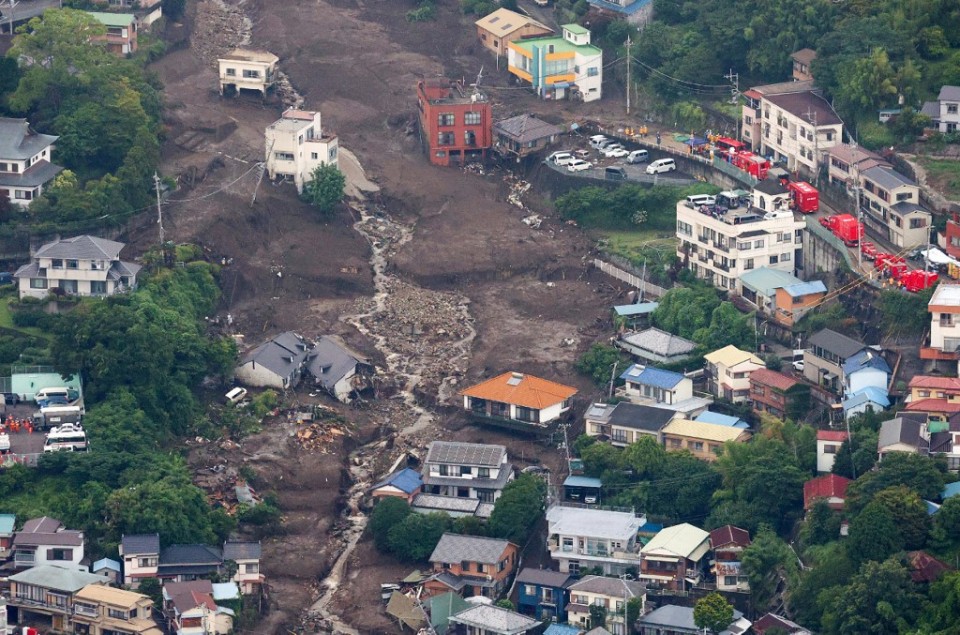
ATAMI, Japan (AFP) — Rescuers were holding out hope of finding at least 64 people buried under the mud and wreckage of a Japanese holiday town that was hit by a devastating landslide, with teams set to resume the desperate search for survivors Tuesday.
Soldiers and emergency workers used hand-held poles and mechanical diggers to sift through the muddy debris, two days after a torrent of earth slammed down a mountainside and through part of the hot-spring resort of Atami in central Japan.
Rescue operations were suspended in the evening and will resume early Tuesday, city officials said.
Four people have been confirmed dead, although officials are struggling to pinpoint the whereabouts of dozens as they scour the wreckage of 130 homes and other buildings that were destroyed.
Pylons were toppled, vehicles buried and buildings tipped from their foundations in the disaster, with aerial footage from the mountaintop showing a stark brown wedge gouged out of the green hillside.
“As of today, at least 64 people are still unaccounted for,” the city’s disaster-management spokesman Yuta Hara told AFP after the city released their names in a bid to gather information about their status.
Prime Minister Yoshihide Suga said the focus was still on finding survivors, with hundreds of rescue workers “doing their best to rescue as many people as possible, as soon as possible”.
The Saturday landslide descended in several violent waves during Japan’s annual rainy season, following days of intense downpours in and around Atami.
Survivors at a nearby evacuation center told AFP on Sunday of their panic when the landslide began.
“When I opened the door, everyone was rushing into the street and a policeman came up to me and said: ‘What are you doing here, you have to hurry, everyone is evacuating!'” resident Kazuyo Yamada said.
“So I went out in the rain in a hurry, without changing, with just a bag.”
Kyodo News said city officials had identified one of the dead as 82-year-old Chiyose Suzuki.
Her eldest son Hitoshi, 56, told Kyodo that he regretted not bringing his mother — who could not walk well — with him when police told them to evacuate.
“I should have gone back and taken her out of there myself” instead of leaving her behind, he was quoted as saying. Suzuki was taken to hospital by rescuers but died there.
More rain forecast
UN Secretary-General Antonio Guterres said he was “saddened” by the reports of the destruction and sent his “deep condolences to the families of the victims, the Government and people of Japan,” according to a statement from his spokesman.
Authorities were examining whether some 54,000 cubic meters of soil left on the mountain by a real estate company in 2007 had contributed to the disaster, according to Kyodo.
Rescuers on Monday took advantage of a break in the rain to continue their search, wading through streams of murky water and moving blocks of timber and other debris out of the way.
Non-compulsory evacuation orders have been issued to more than 35,700 people across Japan, mostly in the Shizuoka region, including Atami, which is around 90 kilometres (55 miles) southwest of Tokyo.
The weather agency forecast heavy rain in the wider region, warning that more landslides could occur.
Atami reportedly recorded more rainfall in 48 hours than it usually does for the whole of July, and survivors told local media they had never experienced such strong rain in their lives.
Scientists say climate change is intensifying Japan’s rainy season because a warmer atmosphere holds more water.
In 2018, more than 200 people died as devastating floods inundated western Japan, and last year dozens were killed as the coronavirus pandemic complicated relief efforts.
© Agence France-Presse







